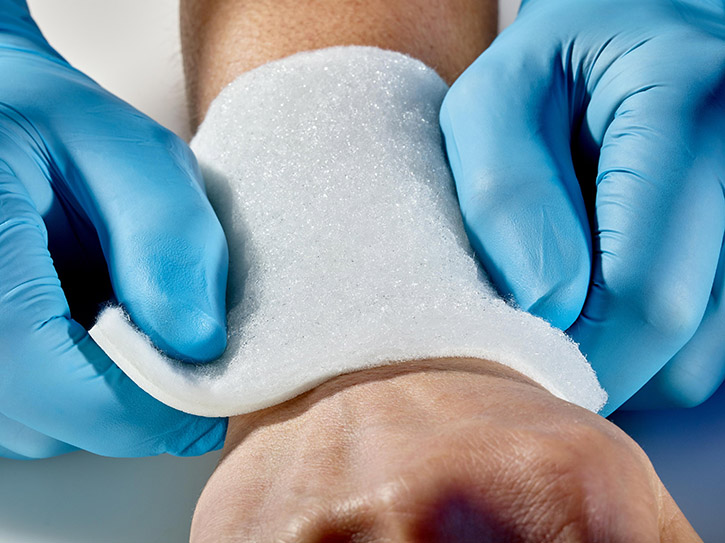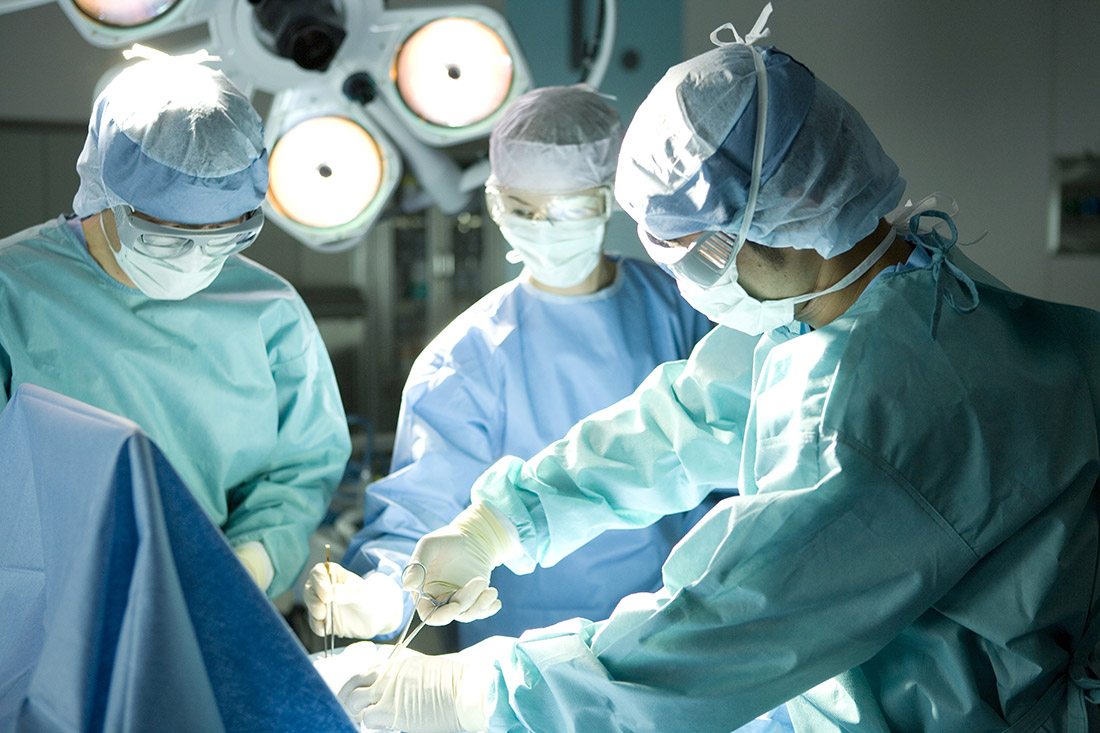The protection of medical personnel, particularly in surgical settings, from viral exposure has never been more important
Textiles are widely used in health and hygiene applications in both medical and consumer markets. They range from simple disposable products, such as baby diapers, feminine hygiene pads, adult incontinence products, and surgical gowns and drapes, to more sophisticated items, such as advanced wound dressings, sutures and vascular grafts, and, most recently, scaffolds for new tissue growth.
Medical textiles are fiber-based products and structures used in first aid or the clinical treatment of a wound or medical condition. The main applications include:
- protective and health care textiles, such as surgical gowns and other apparel, operating room (OR) drapes, sterilization wraps, facemasks, staff uniforms, hospital bedding and curtains, and wipes;
- external devices, such as wound dressings, orthopedic bandages, pressure garments and prosthetic socks;
- implantable materials, such as surgical sutures, vascular and cardiovascular grafts, prostheses and artificial ligaments;
- extracorporeal devices, such as blood filters, artificial livers, artificial kidneys and artificial lungs;
- dental products, such as toothbrush filaments and dental floss/tape.
Hygiene textiles deal with the absorption of natural bodily waste products, specifically urine, feces and menstrual discharge. They include primary nonwovens for use in disposable baby diapers, infant training pants, feminine hygiene products (including sanitary napkins, tampons and panty liners) and adult incontinence products.
Medical and hygiene textiles are manufactured using a wide range of processes:
- extruded polymers can be further processed or used as filaments or tapes in dental floss and toothbrushes;
- braided textiles are used for sutures and to replace damaged tendons and ligaments;
- woven and knitted materials are used extensively in wound dressings and bandages, vascular grafts and hernia meshes; medical products using embroidery technology have also been introduced in recent years;
- nonwovens are primarily manufactured from manmade fibers; their uses include wound dressings, disposable absorbent hygiene products and protective clothing
- a specialized area of medical textiles is the extrusion of hollow fiber membranes used in extracorporeal devices, such as blood filters, artificial kidneys, livers and hearts, and mechanical lungs.
The medical/hygiene textiles sector is dominated by a few, large multinational suppliers. In many respects it can be viewed as a component of the healthcare industry, as well as being an inherent – and rapidly growing – segment of the technical textiles sector.
Natural and manmade fibers
A wide range of natural and manmade fibers is used to manufacture medical textiles, depending on the characteristic required for the end product. Synthetic polymers, which are used extensively, may be permanent, such as polyamide, polyester, polyethylene, polypropylene, polytetrafluoroethylene, polyurethane and polyacrylonitrile, or biodegradable, such as those used in sutures and tissue engineering structures, such as polycaprolactone, polyglycolic acid and polylactic acid.
Besides cotton, silk and regenerated cellulose, natural fibers used in medical textiles include:
- chitin, a polysaccharide from the cells of crustaceans that can be incorporated into wound dressings;
- collagen, a fibrous protein found in connective tissue and tendons, which is used in cell engineering structures, such as artificial skin;
- alginate fibers, which interact with the wound to form an absorbent gel that acts as a protective barrier yet allows the wound to breathe.
Medical textiles made from natural and/or manmade fibers are typically non-toxic, non-carcinogenic, non-allergenic, biocompatible and/or antimicrobial. Other desirable properties can include strength, durability, absorbency and elasticity.
Health care market
The medical/hygiene textiles sector is dominated by a few, large multinational suppliers. In many respects it can be viewed as a component of the health care industry, as well as being an inherent – and rapidly growing – segment of the technical textiles sector.
Health care is one of the world’s largest industries. According to insurance specialists PolicyAdvice, the global health care market was valued at US$8.45 trillion in 2018 and is expected to exceed US$10 trillion by 2022.
The U.S. continues to dominate this market, followed by Europe and Japan – the U.S. alone spends around 15% of its total economy on health care systems, products, equipment and services.
Meanwhile, the global medical devices market was value at US$425.5 billion in 2018 and is expected to reach US$612.7 billion by 2025, a compound annual growth rate (CAGR) of 5.4% over the period, according to a report by Fortune Business Insights.
The global medical textiles market is expected to reach US$20.2 billion by 2022, with surgical dressing products alone accounting for more than half of this market. Nonwoven fabrics dominate the global medical textiles market, with an estimated share exceeding 50%.
Market drivers
Among the current drivers of the health care market are a growing and ageing population, the rising prevalence of chronic conditions (e.g., cardiovascular disease, diabetes and obesity), infrastructure investments, technological advancements, evolving care models, higher labor costs and workforce shortages, and the expansion of health care systems in developing markets.
In the orthopedics sector, technology is driving the market through the introduction of less-invasive and longer-lasting surgical techniques and implants. Meanwhile, technological advances in treating hard-to-heal wounds are driving growth in the active-healing sector of the advanced wound management market.

Wound care
The global wound care market was valued at around US$19 billion in 2018 and is projected to exceed US$33 billion by 2026, according to a recent report from Igate Research.
The wound care sector of the medical products industry is characterized by rapidly evolving technology and intense competition. Many suppliers are large and multinational and have significant resources. In addition, several specialized product companies have formed collaborations with major, established groups to support research, development and commercialization of wound care products.
Academic institutions, government agencies, and other public and private research organizations are also conducting research activities and are commercializing wound care products on their own or through joint ventures.
Although the market for wound care products is large it is also fragmented, with small, local manufacturers of mostly traditional products accounting for around half of all sales.
Conventional wound dressings are used to clean and protect the wound during the initial healing stage or to absorb blood and other wound exudate. These products consist mostly of gauze-based dressings, woven and nonwoven sponges, conforming bandages, non-adherent bandages and pads. Such items still account for the majority of the total wound care dressings market.
Advanced wound care
Fortune Business Insights estimates that the global advanced wound care market was valued at US$10.4 billion in 2019 and is projected to reach US$15.6 billion by 2027, a CAGR of 5.1% over the period.
Advanced wound dressings are designed to stimulate and promote the healing process of acute and chronic wounds and to minimize the risk of scar formation. Predominantly made of synthetic materials, these high-performance – and high-cost – products create a moist environment for the wound, which supports the natural healing process.
Advanced wound dressings have been developed in particular for the treatment of chronic wounds of the elderly population and other hard-to-heal wounds (e.g., diabetic foot ulcers and pressure sores), traumatic wounds (e.g., severe abrasive wounds), burns and certain surgical wounds.
The high cost of these products is a potential barrier to market growth. However, increased efforts are in process to deliver effective and more affordable treatments to the growing pool of elderly consumers. In the U.S. alone, the government estimates a geriatric patient population of more than 55 million, with around 2% of the total population currently suffering from chronic wounds.

Surgical products
Demand for surgical textiles, such as isolation gowns, drapes, caps, facemasks, gloves and shoe covers, is growing as a result of increasing demand for safety and economy. Such products are used in hospital ORs, emergency rooms, clinics and doctors’ offices, both to protect health care personnel and to maintain a sterile environment.
Another driver of demand is the growing number of hospital stays, which is particularly the result of the increased age structure of the population in developed countries.
Other trends affecting the surgical textile market include increasing demand for local supply in developing countries, as global medical companies continue to shift converting operations to this region, and the growing popularity of spunbond fabric, which is claimed to offer higher fluid barriers than traditional spunlace fabrics, as well as lighter basis weights and lower cost.
Wear comfort, both physiological and psychological, is of particular importance to surgeons and other OR personnel, whose efficiency needs to be supported rather than impaired.

The close environment created by the wearing of gowns, gloves and facemasks can increase the potential for heat fatigue, which can contribute to increased mistakes, impaired performance and reduced efficiency.
In addition, it has been found that the provision of adequate physiological comfort for health care workers can have a positive psychological influence, with the comfort of medical apparel affected by thermal/moisture comfort, sensorial comfort and fit/mobility issues.
The protection of medical personnel, particularly in surgical settings, from viral exposure has never been more important, especially during the current COVID-19 pandemic.
In recent decades, the world has also witnessed an increasing incidence of other viruses and contagious diseases, such as human immunodeficiency virus (HIV), methicillin-resistant Staphylococcus aureus (MRSA), Creutzfeldt-Jakob disease (CJD), hepatitis and severe acute respiratory syndrome (SARS), as well as outbreaks of avian and swine influenza.
The global rise in the prevalence of nosocomial infections, otherwise known as hospital-acquired infections (HAIs), has also added to the cyclical parade of pathogens in hospitals and health care facilities.
The global market for disposable medical textiles is expected to grow at a CAGR of 8.3% over the next five years, reaching US$6.8 billion in 2024, up from US$4.2 billion in 2019.
The surgical textile market can be divided into single-use (disposable) and multi-use (reusable) products. Although manufacturers of single-use products face strong competition from reusable textiles, there is a growing usage and acceptance of disposable medical products worldwide.
Single-use products account for more than half of the global market, with the percentage being greatest in the U.S. and Europe. In most other major markets, with the exception of Japan and Australia, reusable textiles are predominantly used.
Growth potential continues to exist in Europe, in particular, where the use of disposable products is around 50% compared with the U.S., where disposable products are used in some 80–90% of surgeries. A keener awareness of postoperative infections and the introduction of standard lump-sum reimbursements are expected to continue this trend.
In Europe, manufacturers and suppliers of both disposable and reusable surgical textiles have adapted to the requirements of European standard EN 13795 (Surgical drapes, gowns and clean air suits used as medical devices, for patients, clinical staff and equipment).


